Are you tired of feeling like you need to break the bank just to enjoy an epic journey?
Well, what if I told you that you don’t have to shell out tons of $$$ to travel the world?
As a fellow student who has mastered the art of stretching every dollar, euro, or yen, I’ve got you covered.
I’ve scoured the globe, experienced my fair share of missed buses, and feasted on more street food than you can imagine, all to bring you the best budget travel tips in the biz.






In this comprehensive guide, we’ll dive deep into the world of budget travel, from planning your trip and finding affordable accommodations to navigating foreign cities like a pro and discovering local secrets that won’t cost a dime.
So, strap in and get ready to take notes as we embark on an adventure that will transform your globetrotting dreams into an affordable reality!
In this post, you'll find...
Step 1: Planning Your Budget Travel Adventure
You know what they say – if you fail to plan, you plan to fail.
The first step to saving money while traveling is setting up a comprehensive plan: including where to go, when to travel, and defining your total travel budget.
Start with a Flexible Destination and Travel Dates
The first key to budget travel is being open-minded about your destination and travel dates.
Instead of zeroing in on one specific location or time frame, do some research to discover the best deals on flights and accommodations.
Being flexible can save you hundreds of dollars and lead to unexpected, unforgettable experiences!
My favorite thing to do when planning a trip is to use Skyscanner’s “Everywhere” and “Cheapest Month” features.
All you have to do is tell them your departure airport and the destination you’d like to travel to, then select “cheapest month” instead of specific dates.
This will tell you the cheapest time to travel to that destination.
On the flip side, you can do the same thing if you have specific dates or a specific month that you know you want to take a vacation, but don’t necessarily have a set destination in mind.




Just put in your desired travel dates and your departing location, then select “Everywhere” into the arrival destination.
You’ll get a list of the cheapest destinations to fly to during the time period you selected.
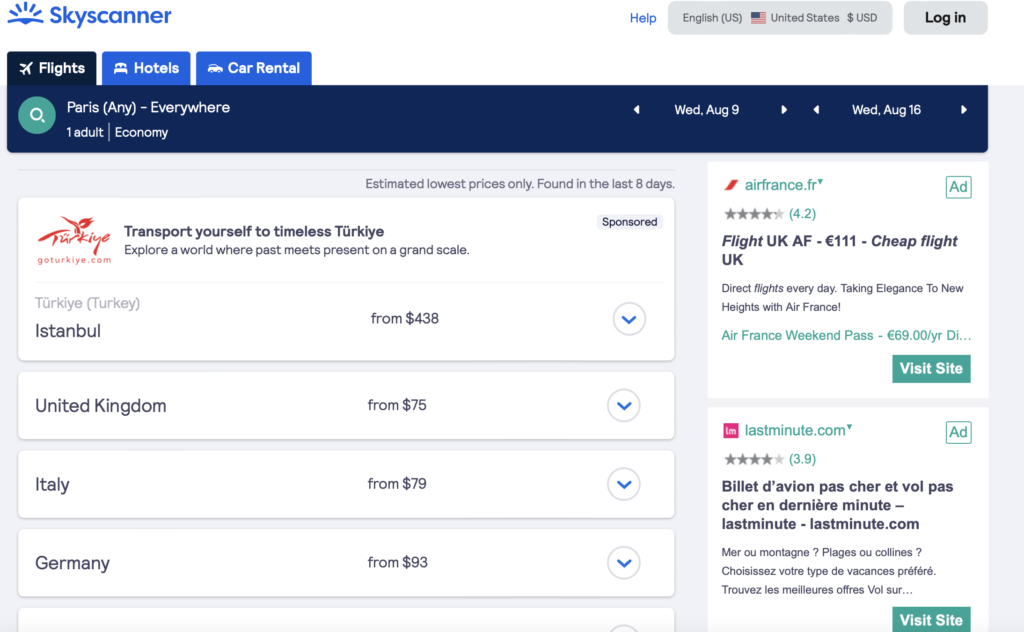



I love using this feature to find great deals on flights that I wouldn’t have found using traditional search methods. It’s also a great way to discover hidden gems and off-the-beaten-path destinations that may not be on your radar!
Search for flights on Skyscanner by clicking here
You should also consider booking with a low-cost airline rather than with one of the mainstream airlines that are usually more expensive.
It may not be as glamorous and you’ll probably not have as much spare room in your seat to stretch your legs, it is a cheaper option and a great budget alternative.
Pro tip: It’s also helpful to think outside the box and explore alternate routes.
Consider flying into a major hub such as Dubai or London, then hopping on budget flights within the region. Not only will this save you money, but it will also give you an opportunity to experience multiple countries in one trip.
Travel During Off-Peak Seasons
To save even more money, avoid traveling in peak season.
Not only will you find lower prices on flights and accommodations, but you’ll also avoid the tourist crowds, giving you a more authentic experience.
Just be sure to research the weather and any potential seasonal closures beforehand.
I know, I know: you want to plan an adventure to Paris in June.
But…
But why not explore the beaches of Costa Rica at a fraction of the cost?
Or visit Chiang Mai in Thailand during their off-season and save big on hotel rooms?
Thinking outside the typical travel times and destination can potentially save you some big bucks on flights and accommodation.
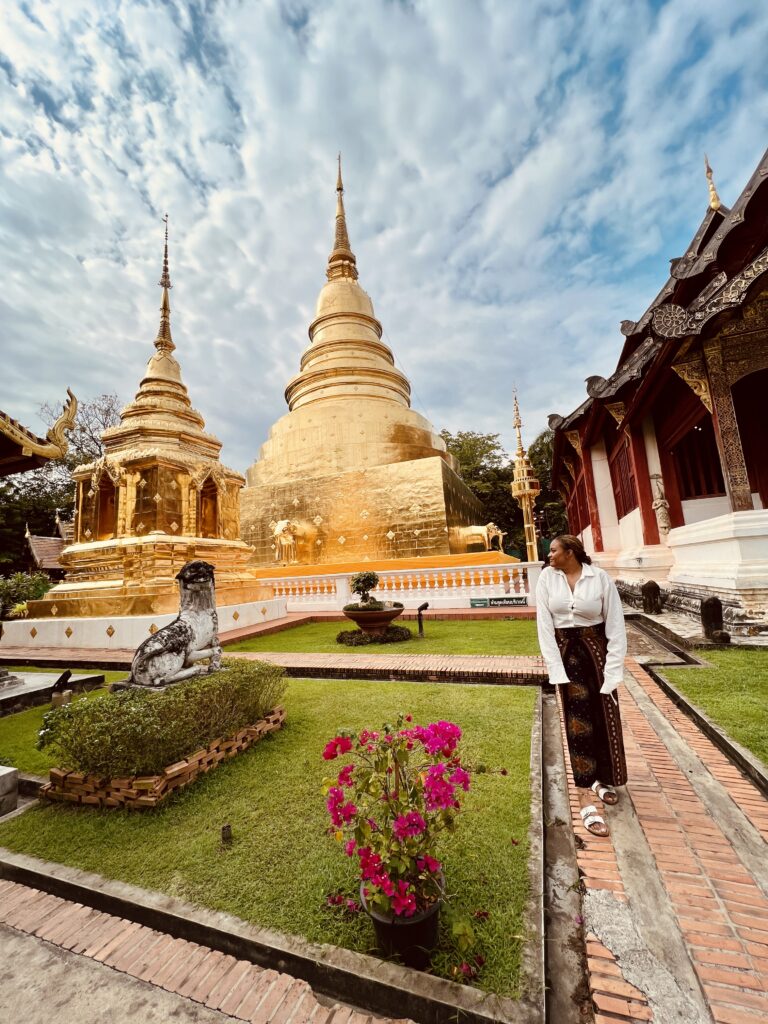



Once you’ve identified a few possible destinations and the ideal times to go, it’s time to begin researching flights.
Booking your tickets early is one of the best ways to save money, but if you don’t have a specific itinerary in mind, sign up for airfare alerts. These alerts will notify you to let you know when prices are at their lowest.
I like to use the app Hopper to set price alerts, which sends me a notification when the price of my desired flight drops. It’s also great for discovering last-minute deals and cancellations!
Use Price Comparison Websites and Apps
Harness the power of technology to find the best deals on flights, accommodations, and transportation.
Websites like Skyscanner, Booking.com, and Kayak offer powerful tools to compare prices for airline tickets, ensuring you get the best bang for your buck.
Don’t forget to sign up for price alerts so you can snag deals as soon as they appear!
I can’t tell you how many times I’ve been able to snag budget flights by waiting for the right time to book.
Just last week, I booked a round-trip ticket from Paris to San Francisco for less than $400 – an incredible deal!
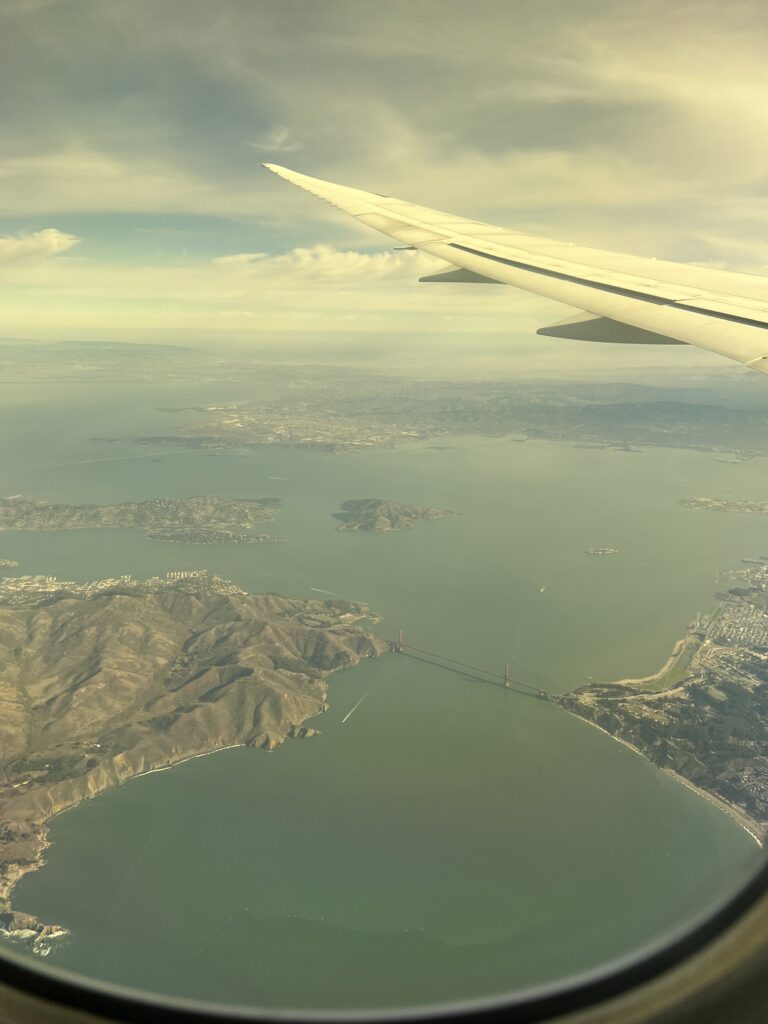



I’d recommend using WayAway to book your flights – not only do they offer cashback on flights, hotels, and activities with their WayAway Plus membership, but they also send you a notification when it’s the best time to buy your tickets.
You can even sign up for paid newsletters like Scott’s Cheap Flights (Recently rebranded to Going) and Airfarewatchdog, which will send you the latest flight deals to your inbox.
Sometimes airlines post mistake fares or offer flash sales, so it’s worth your time to stay up-to-date on the latest offers.
Bottom line: Use the internet to your advantage! With a little bit of research, you can find incredible deals that let you travel for cheap – or even free!
Consider Alternative Modes of Transportation
Flights can be expensive, so why not consider alternative modes of transportation?
Trains, buses, and even car-sharing services can provide budget-friendly options that let you explore at a slower pace and immerse yourself in the local scenery.
If you’re traveling within the United States though, this can be quite difficult.
As advanced as our country is, it simply doesn’t have the infrastructure of most European countries, making it difficult to get from one place to another without spending a fortune.
That being said, there are still ways to make it work.
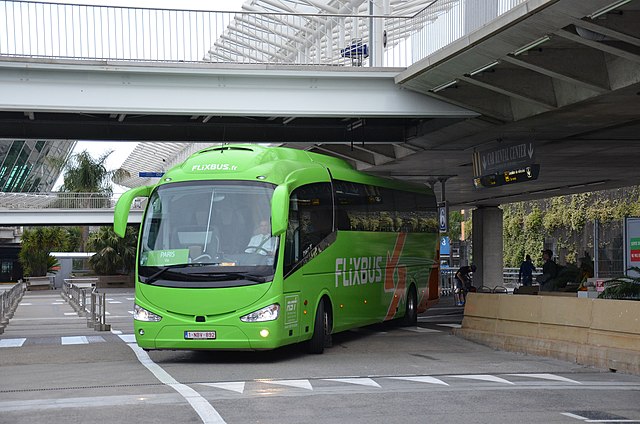



Intercity bus services such as FlixBus and Megabus offer discounts for advanced bookings, while Amtrak trains can be quite affordable if you book your tickets far enough in advance.
If you’re traveling within Europe, train travel is the way to go. Not only are trains cheaper than flights, but they also give you a chance to get acquainted with the local culture and scenery.
And if you happen to be under 26 years old, a Eurail Global Pass is an incredible way to save money.




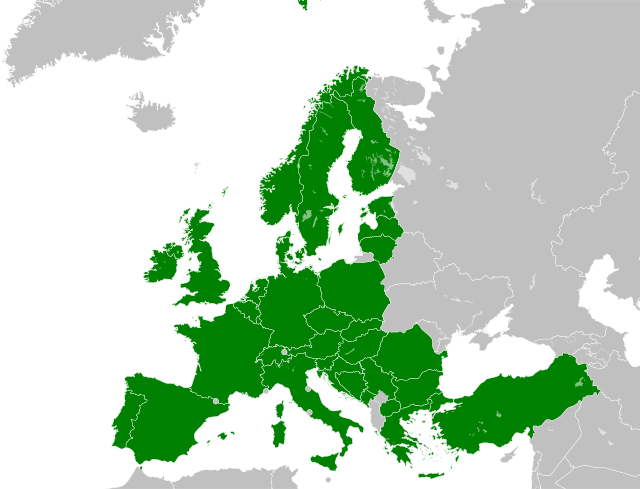



The Eurail Pass lets you visit up to 28 countries in Europe for a fraction of the cost.
If flights and train tickets are too expensive, consider renting a car and making a road trip out of it! This is easy to do in Europe, as many countries have liberal car rental policies.
And since it’s far smaller here than in the US, you can make a road trip out of almost any destination.
Just be sure to check the insurance requirements before you commit!
I always use DiscoverCars when looking for rental cars while traveling – they have consistently offered me the best rates compared to their competitors and their service is great.
Set a Daily Budget and Stick to It
Before you embark on your adventure, determine a realistic daily budget that covers food, accommodations, transportation, and activities.
By setting a daily limit and keeping track of your expenses, you’ll avoid overspending and make your trip more manageable.
It can be tempting to splurge on luxury experiences and accommodations, but the more you can save during your travels, the farther your money will stretch.
I like to budget $20-30 per day for food (depending on what country I’m in) and up to $60 a night for accommodation.
That way I know exactly how much I have to spend and can plan my activities accordingly.
Another great way to save money is by taking advantage of free activities in the destination you’re visiting.
This could include checking out local street art, attending free festivals or markets, exploring public parks, or dipping your toes into the local culture.
Also consider purchasing tickets ahead of time and taking advantage of deals.
For example, if you plan to visit a lot of museums, it may be worth investing in a city pass for discounted entry.
Look for Discounts and Free Activities
When planning your itinerary, search for discounted activities or free things to do, such as museums with no entrance fees or attractions that offer student discounts.
This way, you can experience the best of your destination without breaking the bank.
Many cities also host free walking tours or have beautiful parks and gardens that don’t cost a thing to enjoy.




Not only that, but most of the must-see attractions in any destination can be done for free, or at least cheaply.
Try to think outside of just the major tourist traps!
Instead of paying for a pricey guided tour to see the Eiffel Tower in Paris, for example, you can take a bus up there and save yourself some cash.
Related read: The Best Non-Touristy Things to Do in Paris
And the same thing can be done when it comes to eating while you’re traveling.
Rather than going to the most popular restaurant in town, try visiting a local hole-in-the wall joint. Not only will you save money, but you might end up discovering something truly unique and special.
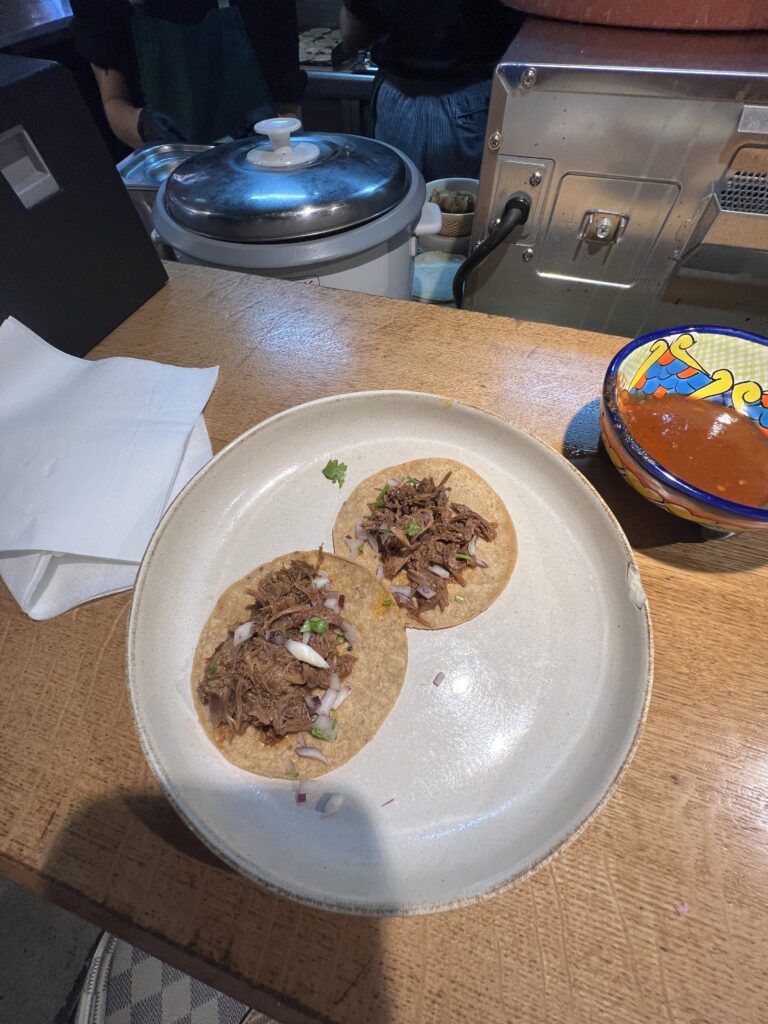



And most of the time, honestly, it tastes even better than the fancier places.
In the next section, we’ll explore more budget travel tips to make the most of your adventure without emptying your wallet.
Stay tuned, fellow frugal explorers!
Step 2: Finding Cheap Accommodation
When it comes to budget travel, booking accommodation and transportation are usually the two highest travel expenses.
But there are plenty of ways to save money on these costs while still getting a comfortable, safe place to stay and reliable means of transport from city to city.
Embrace Hostels and Budget Hotels
If you’re willing to sacrifice a bit of luxury, hostels and budget hotels can save you a ton of money on accommodations.
Not only are they wallet-friendly, but they’re also a great way to meet fellow travelers and swap stories or tips.
I am a huge advocate of staying in hostels while traveling, especially as a solo traveler.
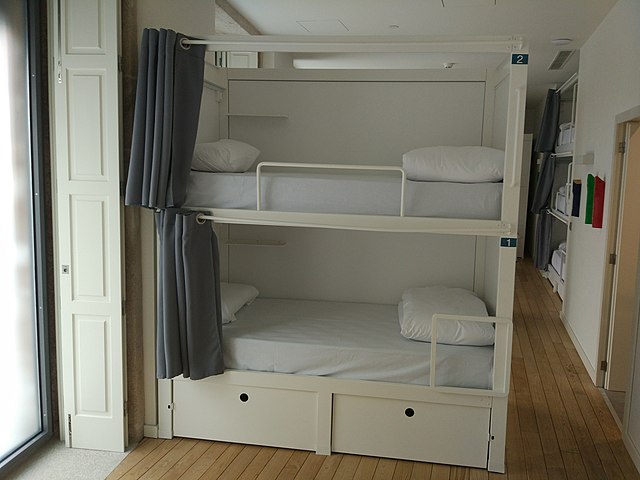



I feel like so many people have such a skewed idea of what hostels are like, but if you know where to look, it’s a great way to stay connected and save cash.
Hostelworld is an awesome resource for finding quality hostels around the world. They have a rating system so you can make sure you’re getting a clean and safe place to stay.
Most hostels offer both shared rooms and private rooms, so you don’t have to worry about sleeping in a dorm if that’s not your thing.
There are also plenty of budget hotels out there that offer comfortable accommodation for an affordable price. Check out sites like Hotels.com or Expedia for deals on these types of accommodations.
Try Homestays, Couchsurfing, or House Swapping
For a more immersive experience, consider a homestay, Couchsurfing, or house swapping. These options can be cheaper (or even free!) and offer unique insights into local culture.
Couchsurfing is a popular option for budget travelers, and it basically involves staying with a local host in their home.




Hosts usually offer up a couch or spare bedroom for free, but you’ll most likely be expected to chip in a bit with groceries or other costs.
House swapping is another great way to save money while traveling.
This involves exchanging your place with someone else for a certain period of time, so you get to stay in their place without having to pay rent or worry about accommodation costs.
One of the best ways to save money on accommodations while traveling is by housesitting.
It’s essentially babysitting… but for someone’s house or apartment. Usually they’ll also have pets or plants to take care of while you’re there too.
It’s a great way to experience new places while also saving money on lodging and a fun way to make new connections at the same time.
Sites like TrustedHousesitters and MindMyHouse can connect you with homeowners who are looking for someone to take care of their property while they’re away.
I’ve used TrustedHouseSitters twice now, and both times I was able to stay in some really amazing locations for free.
The first time was in Rotterdam, The Netherlands, where I was in charge of taking care of a beautiful apartment in the city center and two cute kitties while their owners were on vacation in Portugal.








The homeowners were super nice and gave me a list of restaurants to try and things to do in the area. They even left me their bike to use while they were away!
Housesitting is a great way to save money while also getting to experience some of the more luxurious areas of a destination without having to pay for it.
Whichever route you choose, make sure you research and read reviews before committing to anything. You want to make sure the host is legit and that the accommodations are safe and comfortable.
Just remember to be a respectful guest and return the favor in the future if you can!
Book Accommodations with a Kitchen
Opting for accommodations with a kitchen or kitchenette can save you a fortune on dining out. Cooking your own meals allows you to control your food budget and even try your hand at local recipes.
Plus, it’s an excuse to explore local markets and grocery stores for fresh ingredients!
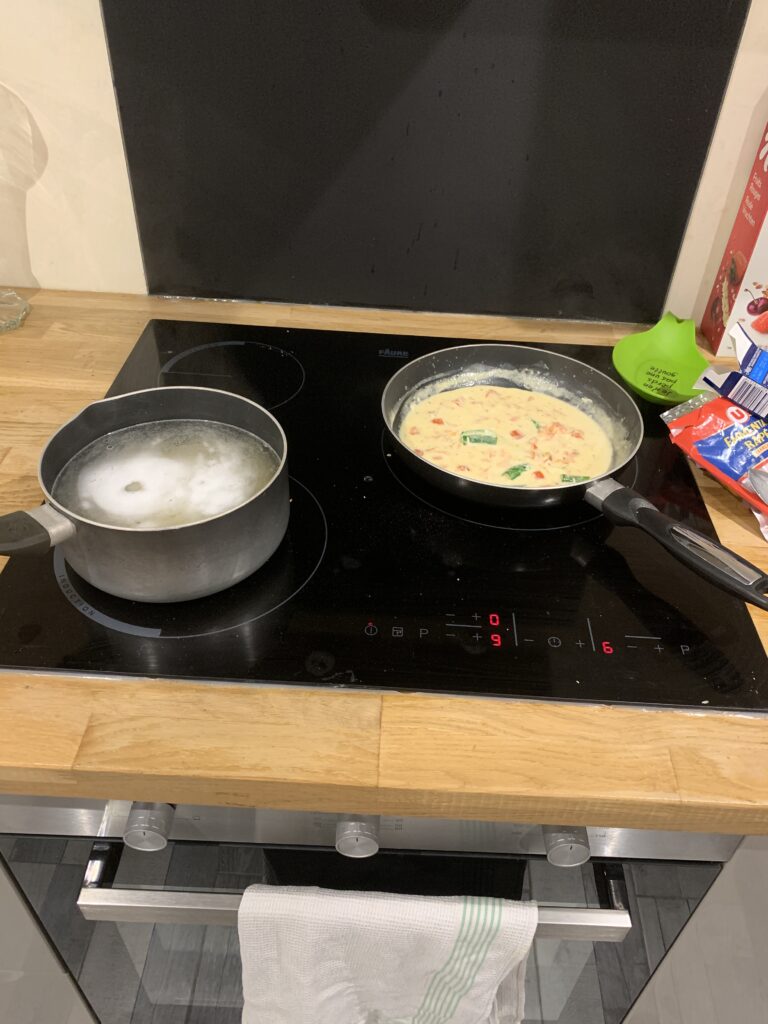



Most hostels will have a kitchen you can use, and many Airbnb listings have kitchens as well.
If you’re staying in an apartment, make sure to ask the owners if there’s any cooking equipment or utensils provided.
Step 3: How to Save Money on Food (while still eating good!)
Food is the main reason why I travel, so I believe it’s important to prioritize it in your budget.
That being said, this doesn’t mean you have to blow all your money on fancy restaurants.
Eat Like a Local
Instead of dining at touristy restaurants, seek out local eateries where you can enjoy authentic cuisine at a fraction of the price.
Street food, food trucks, and local markets are all excellent options for budget-friendly, delicious meals.
Street food is a great way to experience local flavors on the cheap. Street-side stalls are often cheaper than restaurants and offer up delicious dishes from around the world.
And in some regions like Southeast Asia, South America, and Central America, eating street food is cheaper (and often tastes better) than eating in established restaurants.
Just make sure you keep an eye out for cleanliness (if something looks questionable, it’s probably best to avoid).
P.S. I’ve written a whole guide on how to avoid getting food poisoning in Thailand – this can apply to many other countries too!
Check that out next to learn more about what to look out for before consuming street food, and what to do if it does, unfortunately, make you sick.
Pack Reusable Water Bottles
To avoid spending unnecessary money on drinks, pack your own and carry a reusable water bottle.
This not only saves you money but also helps reduce plastic waste, contributing to a more sustainable travel experience.
Depending on where you’re traveling, many places offer water for free (or at a discounted price) at restaurants, convenience stores, and public water fountains.
If you’re not sure if tap water is safe to drink in your destination, do some research before you go or ask a local what they recommend.
You can also consider investing in a filtering bottle if that’s an option in your destination. This can save you money and also prevents the need for single-use plastic bottles as you can filter tap water on-the-go.
I personally love my Lifestraw Go bottle – it’s been a lifesaver (literally) when I’ve traveled to places where the drinking water wasn’t potable.
And if you’re in a pinch and need to buy bottled water, make sure to bring your own instead of buying new ones. Buying reusable bottles helps cut down on waste and also prevents you from spending extra money.
Take Advantage of Happy Hours and Meal Deals
To save even more money on food while traveling, look for restaurants with happy hour deals or discounted meals.
You can score discounts on food and drinks, making your dining experience more budget-friendly.




And if you’re staying in a hostel, most hostels offer discounts for guests at their onsite bar and set up bar crawls throughout the city.
I like to use the app TooGoodToGo to find cheap food when traveling – it’s a great way to find delicious meals with discounts of up to 90% off! Restaurants list their surplus food on the app, and you can pick it up at a discounted price.
Don’t be afraid to ask around too – many places have hidden discounts that aren’t advertised.
Ask locals or employees if they know of any discounts or meal deals offered for travelers.
You may also check online forums to see what other travelers are saying about the place you’re visiting.
Step 4: Saving on Activities and Sightseeing
What fun is budget traveling if you can’t do any of the fun activities?
While sightseeing may cost a bit, there are ways to save money on attractions and experiences.
Plan Your Sightseeing Wisely
Create a sightseeing plan that maximizes your time and money. Group attractions by location, so you can save on transportation costs and avoid backtracking.
Research free admission or discounted entry days at museums and galleries, and prioritize must-see attractions.
In Paris, for example, museum entry is free for everyone on every first Sunday of the month.
And if you’re traveling in Europe, consider investing in a city pass or discounted tourist tickets for discounts on multiple attractions and public transport.
Or… find a cute local boy to give you a free tour of the city on his motorbike.
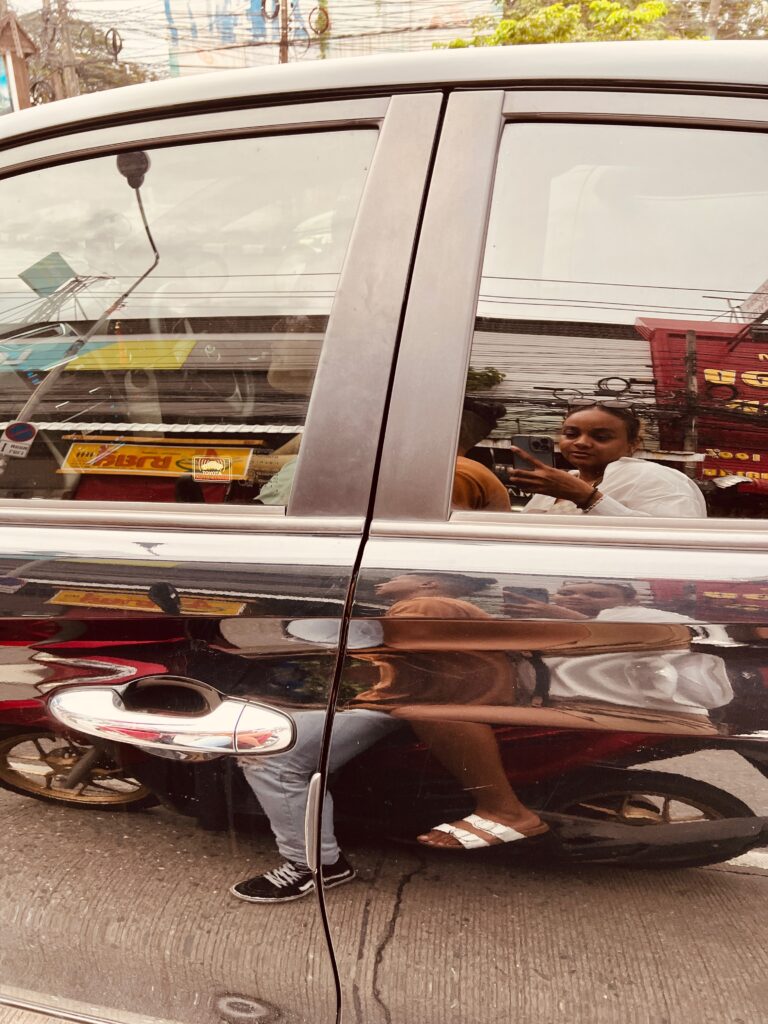



Utilize Free or Low-Cost City Tours
Many cities offer free or low-cost walking tours led by local guides. These tours can be a great introduction to a destination and often cover major sights, history, and local culture.
You can use sites like Viator and GetYourGuide to find walking tours in destinations around the world.
Another great way to explore a city is by bike – many cities offer free or discounted bike rentals as well as guided cycling tours at low prices.
This can be a great way to see the sights while also getting some exercise.
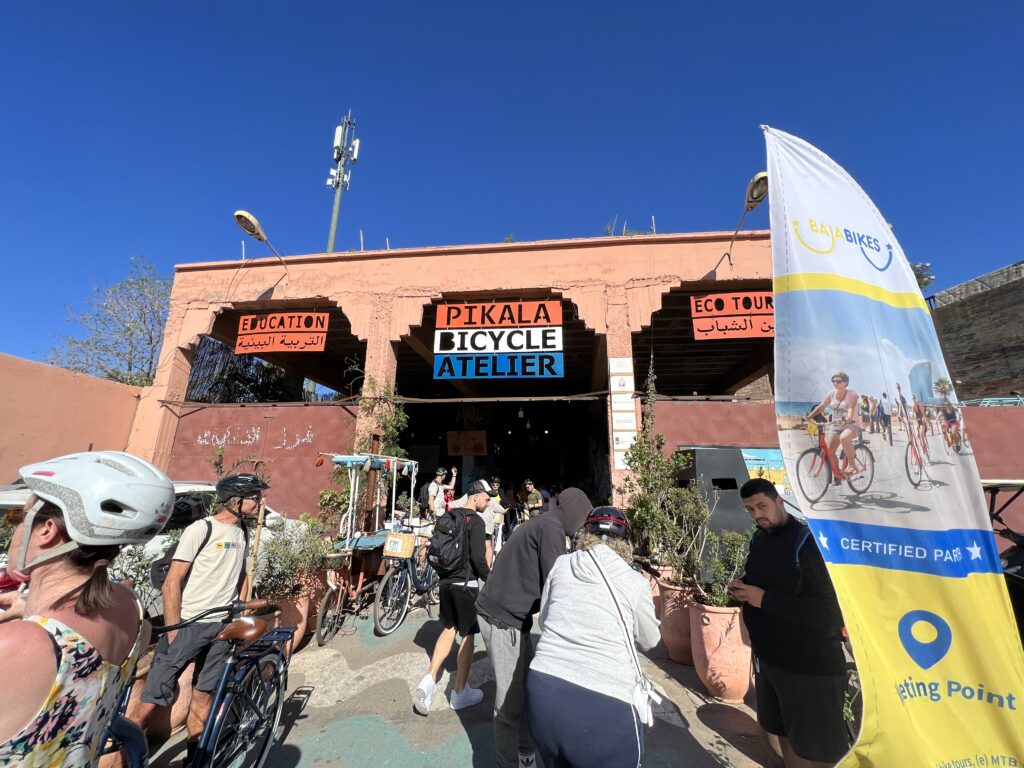



Finally, don’t forget about nature! Exploring parks and nature trails is usually free, and you can often find stunning views this way.
Leverage Travel Apps and Digital Resources
There’s a wealth of free travel apps and digital resources available to help you navigate, plan, and save money on your trip.
From public transportation apps to currency converters and language tools, these digital resources can make your budget travel experience smoother and more enjoyable.
Some of the must-have travel apps you’ll need when traveling include:
- Google Translate (for obvious reasons)
- TooGoodToGo (the discounted food app I mentioned earlier)
- CityMapper and/or Google Maps (for reliable transport info)
- Duolingo (to learn the basics of a foreign language)
- XE Currency Converter (for up-to-date currency exchange rate info)
- Uber, Bolt, and/or Blablacar (alternative transportation options)
Extra Practical Budget Travel Hacks to Know
Here are a few practical tips and hacks to help you save even more money on budget travel:
Travel with a Portable Charger
A portable charger is an essential tool for budget travelers.
It ensures you have access to your digital resources, such as maps and booking confirmations, without the need to search for an outlet in a café or pay for a charging station.
I use a lightweight, versatile power bank that can be easily tucked into my pocket or travel bag. It’s an invaluable travel accessory that I never leave home without!
Embrace Travel Insurance
While it may seem counterintuitive to spend money on travel insurance, it can save you a lot in the long run.
Accidents and unexpected events can happen, and having coverage can help you avoid costly medical bills or trip interruptions.
I seriously cannot stress the importance of having travel insurance enough.
I recently had to cancel a trip due to illness and was able to get my money back thanks to the coverage provided by my travel insurance policy (thank you, SafetyWing).
I use SafetyWing for most of my trips, but there are plenty of other companies that offer similar travel insurance policies. Make sure to do your research and read the fine print before purchasing a policy!
Learn Basic Phrases in the Local Language
Knowing a few basic phrases in the local language can help you navigate unfamiliar places, avoid tourist traps, and even negotiate better prices.
For example, I once asked a taxi driver in Cancun for the cheapest way to my destination (in my broken Spanish) and he gave me his personal car at a fraction of what it would have cost had I taken a regular taxi.
So don’t be shy – try to learn some basic phrases in the language spoken wherever you go!
The locals appreciate the effort and it will almost always lead to friendlier interactions and valuable insider tips.
Pack Light (and Smart)
This is another essential budget-saving hack. The lighter you pack, the less you’ll have to pay for checked luggage fees (especially when flying).
You won’t need to worry about carrying heavy bags either, saving you time and energy that can be better spent elsewhere.
Focus on versatile clothing items that can be mixed and matched, and consider travel-sized toiletries.
Remember, you can always do laundry or buy essentials at your destination if needed.
Also, consider bringing packing cubes – they make organizing clothes and items much easier!
I always bring my BAGAIL packing cubes with me – they’re a game changer when it comes to packing light!
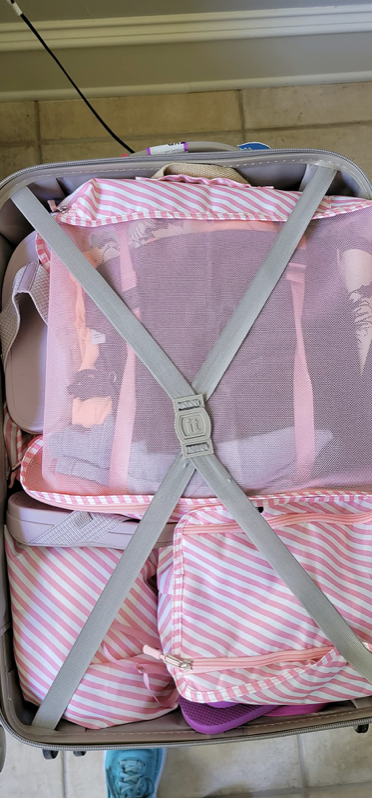



They come in a few different color options, and you can order them on Amazon here.
Related read: How to Pack for Multiple Destinations (without overpacking)
Opt for Public Transportation or Rideshares
Taxis and private car services can quickly eat into your budget.
Instead, opt for public transportation, which is usually cheaper and can provide a more authentic glimpse into local life.
In Western Europe especially, public transportation is almost always the best option – they are (usually) reliable, clean, and comfortable.
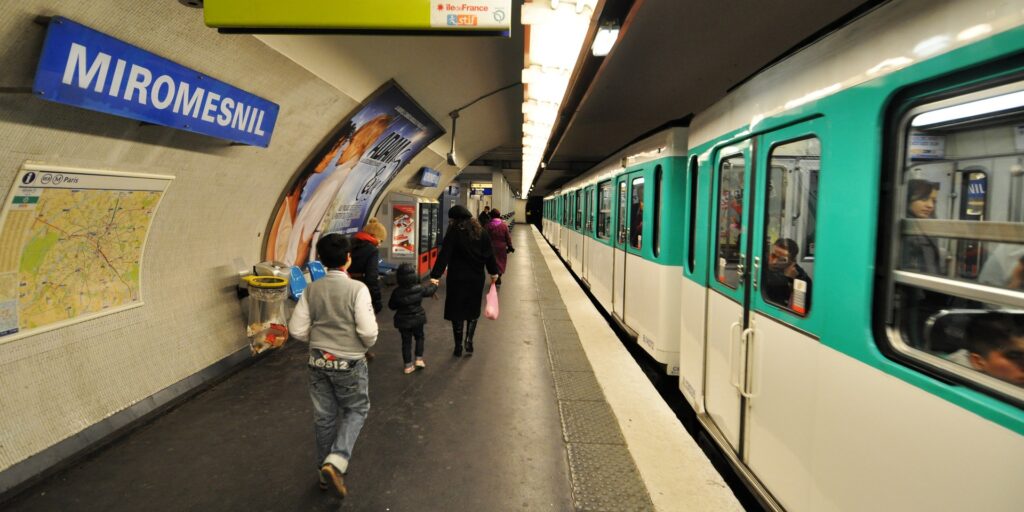



Trains are a great choice as well!
Even if you don’t get a discounted fare (by purchasing advance tickets), the regular fares are often quite reasonable.
Rideshare apps like Uber and Lyft can also be a cost-effective alternative, especially when traveling with friends or in a group.
Use a Credit Card with No Foreign Transaction Fees
Using a credit card with no foreign transaction fees can save you a lot in the long run. Not only do these cards help you avoid extra fees, but they often come with perks like travel rewards or insurance.
Just make sure to pay off your balance every month to avoid interest charges!
I have a crippling fear of having credit card debt, so I don’t currently use any travel cards and therefore don’t have one to personally recommend.
But some of the most popular travel credit cards that I know of include the Chase Sapphire Preferred Card and the Delta SkyMiles® Reserve American Express Card.
Think outside of the box and find creative ways to save money
Get out of your comfort zone and think of some creative ways to save money on your trip.
For example, you could stay with a local host or volunteer in exchange for lodging.
You can also look out for happy hour specials at bars, take advantage of all-you-can eat buffets, or ask if your hotel offers discounts for extended stays.
Trust me, there are tons of ways to save money on travel if you’re willing to be creative and step out of your comfort zone a little!
Don’t sacrifice fun
Finally, don’t forget about the most important part of budget travel: having fun! There’s no point in saving money if you’re not going to enjoy yourself.
If there are certain activities or experiences you can’t miss, don’t be afraid to splurge on them.
At the same time, try to remember that money isn’t everything – some experiences are priceless and it’s these memories that will last a lifetime.
So make sure to balance your budgeting with some good old-fashioned fun!
Bonus tip: Stay Connected and Informed
Follow Travel Blogs and Social Media Accounts
Stay up-to-date on the latest budget travel tips, deals, and destination inspiration by following travel blogs and social media accounts. These platforms can be a treasure trove of information and resources for saving money on your next adventure.
Join Travel Communities and Forums
Online travel communities and forums are a great place to ask questions, share experiences, and learn from fellow budget travelers. From Reddit’s r/travel to Lonely Planet’s Thorn Tree forums, there’s a wealth of knowledge and advice at your fingertips.
Sign Up for Travel Newsletters and Deal Alerts
Many airlines, booking websites, and travel companies offer newsletters and deal alerts, which can help you stay informed about promotions and discounts. Sign up for these alerts to be among the first to know about money-saving opportunities.
Final thoughts
There you have it, the ultimate guide to budget travel!
With these tips, tricks, and hacks, you’ll be well on your way to saving money and making your next adventure more affordable.
Remember, traveling on a budget doesn’t mean sacrificing amazing experiences; it just requires a little creativity and resourcefulness. 😉
FAQ
What are some tips for traveling cheaply?
Some tips for traveling cheaply include looking out for airfare sales, using rideshare apps like Uber and Lyft, using a credit card with no foreign transaction fees, thinking creatively to save money, and staying up-to-date on the latest budget travel tips.
How can I save for 6 months of travel?
To save for 6 months travel, consider cutting back on unnecessary expenses and finding ways to make extra money. You can also open a separate savings account specifically dedicated to your travels – this way the money will be more accessible when you’re ready to book your trip.
What are some ways to find deals on accommodations?
Some ways to find deals on accommodations include booking directly with a hotel or hostel, using websites like WayAway, Airbnb, and Booking.com, joining loyalty programs, looking out for flash sales, and asking your hotel if they offer discounts for extended stays.
What is the least expensive time to travel?
The least expensive time to travel is usually during the off-season or shoulder season, which is typically between winter and summer. Airfares are often lower during this time and you may find better deals on accommodations. Fewer crowds usually also mean more relaxed sightseeing experiences!
Hi, I’m Tiana – founder of and author here at Where Tiana Travels. I’m a 20-something with a love for all things travel, photography, and food. I have been living abroad for the past 5 years and solo traveling the globe in my free time. I created this blog to share my travel stories and inspire other women to go out and see the world. Read more about me here!


Thrifty Travelers’ Treasure Trove: Money-Saving Hacks for Budget Adventures – LashWorld
Thursday 10th of August 2023
[…] of your adventures. In this article, you’ll discover insider tips from experienced budget travelers on how to save hundreds of dollars on your next trip. From booking strategies and packing […]
When is the Best Time to Visit Paris? Weather & Price Guide (2023) | Where Tiana Travels
Thursday 27th of April 2023
[…] Check out my Ultimate Guide to Budget Travel for Beginners to find my top tips for booking cheap flights and accommodation all over the […]